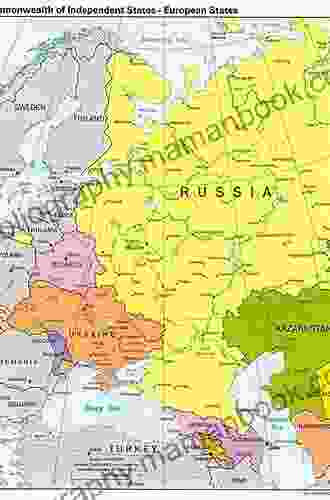Central and Eastern Europe and the CIS: A Comprehensive Overview

4.5 out of 5
| Language | : | English |
| Text-to-Speech | : | Enabled |
| Enhanced typesetting | : | Enabled |
| Word Wise | : | Enabled |
| File size | : | 2360 KB |
| Screen Reader | : | Supported |
| Print length | : | 121 pages |
Central and Eastern Europe (CEE) and the Commonwealth of Independent States (CIS) are two regions of the world that share a common history and culture. They were both part of the Soviet Union until its collapse in 1991, and they have since transitioned to independent states.
CEE includes the countries of Estonia, Latvia, Lithuania, Poland, Czech Republic, Slovakia, Hungary, Romania, Bulgaria, and Albania. The CIS includes the countries of Armenia, Azerbaijan, Belarus, Georgia, Kazakhstan, Kyrgyzstan, Moldova, Russia, Tajikistan, Turkmenistan, Ukraine, and Uzbekistan.
CEE is a diverse region with a rich history and culture. The region is home to a variety of ethnic groups, languages, and religions. CEE is also a major economic and political player in the world.
The CIS is a region of cooperation between the former Soviet republics. The CIS was established in 1991 to promote economic and political cooperation between its member states. The CIS is not a formal alliance, but it does provide a forum for cooperation on issues such as trade, security, and energy.
History
CEE and the CIS have a long and complex history. The region was first settled by Slavic peoples in the 6th century AD. The Slavs established a number of kingdoms and principalities in the region, which were eventually conquered by the Mongols in the 13th century.
The Mongols ruled CEE for over two centuries, and their rule had a profound impact on the region. The Mongols introduced a new style of government and military organization to CEE, and they also spread Islam to the region.
After the collapse of the Mongol Empire, CEE was divided into a number of small states. The most powerful of these states was the Kingdom of Poland, which emerged in the 14th century. Poland was a major power in Europe for several centuries, but it was eventually partitioned by its neighbors in the late 18th century.
In the 19th century, CEE was dominated by the Russian Empire. Russia expanded its territory into the region, and it eventually annexed Poland and the Baltic states.
After the Russian Revolution in 1917, CEE was divided into a number of independent states. The most powerful of these states was the Soviet Union, which was established in 1922. The Soviet Union included most of CEE, as well as the Baltic states and the Caucasus region.
The Soviet Union collapsed in 1991, and CEE was once again divided into a number of independent states. The countries of CEE have since transitioned to democracy and market economies, and they have become increasingly integrated into the European Union.
Culture
CEE and the CIS have a rich and diverse culture. The region is home to a variety of ethnic groups, languages, and religions. CEE is also known for its art, music, and literature.
The most common languages spoken in CEE are Slavic languages, such as Polish, Czech, and Russian. However, there are also a number of other languages spoken in the region, such as Hungarian, Romanian, and Albanian.
CEE is a predominantly Christian region, with the majority of the population belonging to the Eastern Orthodox Church. However, there are also significant minorities of Catholics, Protestants, and Muslims in the region.
CEE is known for its rich artistic tradition. The region is home to a number of famous artists, such as Leonardo da Vinci, Michelangelo, and Rembrandt. CEE is also known for its music, which includes a variety of genres, such as classical music, folk music, and pop music.
Economy
CEE and the CIS are major economic players in the world. The region is rich in natural resources, such as oil, gas, and minerals. CEE is also a major manufacturing center, and it produces a variety of goods, such as automobiles, electronics, and textiles.
The economies of CEE are transitioning from the communist era to a market economy. The countries of CEE have made significant progress in this transition, but they still face a number of challenges, such as unemployment, corruption, and organized crime.
The CIS is a major economic bloc in the world. The CIS countries cooperate on a variety of economic issues, such as trade, investment, and energy.
Politics
CEE and the CIS are regions of political diversity. The countries of CEE are all members of the European Union, and they are closely aligned with the West. However, the countries of the CIS have a more diverse political orientation, with some countries being more closely aligned with Russia than others.
The politics of CEE are dominated by a number of different parties, including center-right parties, social democratic parties, and nationalist parties. The politics of the CIS are also dominated by a number of different parties, including communist parties, nationalist parties, and democratic parties.
Geography
CEE and the CIS are located in the eastern part of Europe and the western part of Asia. The region is bordered by the Baltic Sea to the north, the Black Sea to the south, and the Ural Mountains to the east.
CEE is a region of diverse geography, including mountains, forests, plains, and rivers. The highest mountain in CEE is Mount Triglav in Slovenia, which has an elevation of 2,864 meters (9,396 feet).
The CIS is a region of even greater geographical diversity, including deserts, steppes, mountains, and forests. The largest desert in the CIS is the Karakum Desert in Turkmenistan, which covers an area of 350,000 square kilometers (135,544 square miles).
Travel
CEE and the CIS are popular tourist destinations. The region is home to a number of beautiful cities, historic sites, and natural attractions. Some of the most popular tourist destinations in CEE include Prague, Budapest, Vienna, and Krakow. Some of the most popular tourist destinations in the CIS include Moscow, St. Petersburg, and Kiev.
CEE and the CIS are easily accessible by plane, train, or car. The region is served by a number of major airports, including Prague Airport, Budapest Airport, and Moscow Sheremetyevo International Airport.
CEE and the CIS are two regions of the world that share a common history and culture. The region is diverse in terms of its geography, economy, politics, and culture. CEE and the CIS are also important players in the world economy and politics.
4.5 out of 5
| Language | : | English |
| Text-to-Speech | : | Enabled |
| Enhanced typesetting | : | Enabled |
| Word Wise | : | Enabled |
| File size | : | 2360 KB |
| Screen Reader | : | Supported |
| Print length | : | 121 pages |
Do you want to contribute by writing guest posts on this blog?
Please contact us and send us a resume of previous articles that you have written.
 Top Book
Top Book Novel
Novel Fiction
Fiction Nonfiction
Nonfiction Literature
Literature Paperback
Paperback Hardcover
Hardcover E-book
E-book Audiobook
Audiobook Bestseller
Bestseller Classic
Classic Mystery
Mystery Thriller
Thriller Romance
Romance Fantasy
Fantasy Science Fiction
Science Fiction Biography
Biography Memoir
Memoir Autobiography
Autobiography Poetry
Poetry Drama
Drama Historical Fiction
Historical Fiction Self-help
Self-help Young Adult
Young Adult Childrens Books
Childrens Books Graphic Novel
Graphic Novel Anthology
Anthology Series
Series Encyclopedia
Encyclopedia Reference
Reference Guidebook
Guidebook Textbook
Textbook Workbook
Workbook Journal
Journal Diary
Diary Manuscript
Manuscript Folio
Folio Pulp Fiction
Pulp Fiction Short Stories
Short Stories Fairy Tales
Fairy Tales Fables
Fables Mythology
Mythology Philosophy
Philosophy Religion
Religion Spirituality
Spirituality Essays
Essays Critique
Critique Commentary
Commentary Glossary
Glossary Bibliography
Bibliography Index
Index Table of Contents
Table of Contents Preface
Preface Introduction
Introduction Foreword
Foreword Afterword
Afterword Appendices
Appendices Annotations
Annotations Footnotes
Footnotes Epilogue
Epilogue Prologue
Prologue Lucia St Clair Robson
Lucia St Clair Robson Peter Turchi
Peter Turchi Listastik
Listastik Peter Roger Breggin
Peter Roger Breggin Michael J Behe
Michael J Behe Liv Constantine
Liv Constantine Amber Nicole
Amber Nicole The Junior League Of Tampa
The Junior League Of Tampa John Buchan
John Buchan Lichelle Slater
Lichelle Slater Concha Delgado Gaitan
Concha Delgado Gaitan Deandre Dean
Deandre Dean Seth Kinstle
Seth Kinstle Kenneth W Noe
Kenneth W Noe Stephanie Casemore
Stephanie Casemore Michelle Zauner
Michelle Zauner Amber Lewis
Amber Lewis Caterina Christakos
Caterina Christakos Kennette Thigpen
Kennette Thigpen Saryu Bathia
Saryu Bathia
Light bulbAdvertise smarter! Our strategic ad space ensures maximum exposure. Reserve your spot today!

 Heath PowellUnveiling the Enigmatic World of 'In the Company of Fools': A Comprehensive...
Heath PowellUnveiling the Enigmatic World of 'In the Company of Fools': A Comprehensive...
 Eric NelsonDelphi Complete Works of William Congreve: A Literary Masterpiece Illustrated...
Eric NelsonDelphi Complete Works of William Congreve: A Literary Masterpiece Illustrated... Finn CoxFollow ·9.4k
Finn CoxFollow ·9.4k Jeremy MitchellFollow ·11.4k
Jeremy MitchellFollow ·11.4k Donovan CarterFollow ·6.9k
Donovan CarterFollow ·6.9k Gerald ParkerFollow ·10.4k
Gerald ParkerFollow ·10.4k Caleb CarterFollow ·16.9k
Caleb CarterFollow ·16.9k Bradley DixonFollow ·13.1k
Bradley DixonFollow ·13.1k Colby CoxFollow ·12.6k
Colby CoxFollow ·12.6k J.R.R. TolkienFollow ·2.8k
J.R.R. TolkienFollow ·2.8k

 Patrick Rothfuss
Patrick RothfussHow to Make a Million Dollars: No Secrets
Making a million dollars...

 Robert Heinlein
Robert HeinleinResponse to Intervention, Second Edition: RTI in Practice
A Comprehensive Resource for Educators and...

 Timothy Ward
Timothy WardUnravel the Gripping Assassination Thriller Bursting with...
Prepare yourself for a...
4.5 out of 5
| Language | : | English |
| Text-to-Speech | : | Enabled |
| Enhanced typesetting | : | Enabled |
| Word Wise | : | Enabled |
| File size | : | 2360 KB |
| Screen Reader | : | Supported |
| Print length | : | 121 pages |














